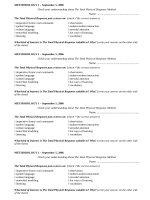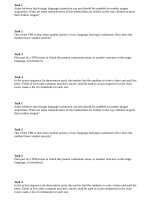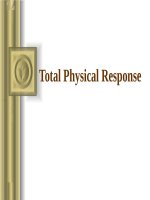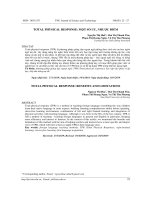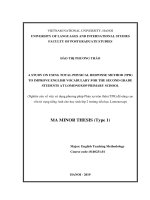Total physical response (TPR)
Bạn đang xem bản rút gọn của tài liệu. Xem và tải ngay bản đầy đủ của tài liệu tại đây (38.72 KB, 5 trang )
University of Languages and International Studies
Faculty of English Language Teaching Education
INTRODUCTION IN TO ENGLISH LANGUAGE TEACHING METHODOLOGY
A REPORT ON
TOTAL PHYSICAL RESPOND (TPR)
METHOD
by
GROUP 1 – 17E5
1
2
3
Members
Nguyễn Kỳ Anh
Ngô Thị Phương
Lê Linh Chi
4
Lại Phương Thảo
5
Kiều Thùy Trang
Work Division
Method’s Description (ADP)
Method’s Description (ADP)
Method’s Evaluation
Application
Report finalization
Method’s Evaluation
Power Point
Presenter
Method’s Description and Evaluation
Power Point
Presenter
Developed by psychologist James Asher in the 1970s, the total physical
response (TPR) teaching methodology has been applied in foreign language
teaching all over the world. This essay will look at the 3 keys concept of TPR, as
well as evaluate its effectiveness based on 5 main principles.
Total Physical Response (TPR) is a language teaching method specifying
the coordination of speech and physical movement. Asher’s method views
language as a tool containing structural features to influence the behavior of
others. One fundamental foundation of TPR associates with theory of mother
tongue acquisition, which indicates that either a child or an adult has an aptitude
for acquiring a language through comprehensible input and motor activities. This
is evident in how infants acquire their first language by the unique “languagebody conversation” with their parents. Asher believes that L2 learners “learn”
better when body movement are involved.
Although applicable to learners at any level, TPR’s primary target is to
teach spoken language to L2 beginners. The ultimate goal of this method is for
learners to achieve oral proficiency, fundamentally listening comprehension.
Learners progress through a "silent stage" in which they are not forced to speak
until they are ready or spontaneously do so. In TPR, the teacher has complete
control over the choice of content and language items. However, the selection of
items should utilize the imperative form, which are expressive and situational, as
well as trigger the learners to enact. By repeating the commands and modelling
the actions, the teacher introduces the lexical and grammatical items, while the
learners follow as receivers and responders. As a supplementary role, materials
such as word charts, slides, pictures and realia can be used to illustrate the
vocabulary.
The selected items can progress from concrete to abstract. As learners
progress to a higher level, teachers and students’ roles are reversible. Teachers
can give a sequence of actions, add more complex lexical items to the command
and students may give commands to the others. TPR also aims at a stress-free
learning environment; therefore, learners are allowed to make errors with little
correction or correction in a non-threatening way from the teacher. Classes are
taught primarily in the target language in order for learners to practice listening
comprehension, especially the repetition of imperative drills. The activities focus
on learners performing the actions and later on giving commands.
Upon reflecting TPR on the 10 principles of instructed language learning by
Rod Ellis, we briefly consider the advantages and disadvantages of this method.
Initially, the emphasis in TPR is on meaning comprehension, specifically
semantic meaning. Particularly, learners show their comprehension of the lexical
items or grammatical structures by being able to respond nonverbally to the
teacher’s commands, and at a more advanced level, may give commands to
other students. However, the selected items are concrete and situational, which
predominantly are nouns and action verbs, with few variations of more abstract
or highly contextualized words and phrases (e.g. slowly vs carefully, look down,
…). Therefore, learners may encounter difficulty in identifying the abstract
vocabulary and its pragmatic meaning. Secondly, TPR provides learners with
extensive input of the target language. In other words, in a TPR-adopted
classroom, students are frequently exposed to the target language thanks to
maximum use of L2 in instructions, as well as the repetitive use of imperative
drills. By being a performer and a commander, learners can develop their oral
proficiency. Moreover, learners may receive advantages for developing a rich
source of formulaic chunks (e.g. brush one’s teeth, sweep the floor). On the other
hand, TPR pays little focus on grammatical rules explanation, resulting in
learners internalize the fixed sequences but may not consciously produce
grammatically-correct sentences. Finally, by employing TPR, teachers can
create a more active and exciting classroom atmosphere compared to the other
methods. Motor activities generate such positive energy that keeps the learners
focus and engaged in the lesson. Furthermore, students are likely to benefit from
the stress-free studying environment. For instance, learners can self-correct by
looking at their peers or having teacher re-modeling the actions, which make
them less anxious. Nevertheless, TPR is more suitable for classes of learners at
a young age or at beginning level or preproduction stage with the selection of
simple patterns. It facilitates the natural emergence and development of oral
communication, while the output of writing and contextualized communication is
not ascertained.
To summarize, it seems like TPR as a teaching method holds both merits
and demerits in terms of objectives, content, learners’ features and classroom
environment. Therefore, it is important that the teachers have a thorough
knowledge of this method in order to adopt and adapt it effectively.
REFERENCE LIST
1. Jack C. Richards, Ted Rogers. (1982). TESOL Quarterly, Vol.16, No.2,
153-168
2. METHOD OF LANGUAGE TEACHING. (n.d.). Retrieved from
/>fbclid=IwAR0XZOeercJCrMxmC4g39ZEXiyJZH474vkQDx2Eyh0qyOt8ggdPbacWcsM
3. Ellis, R. (2005). Principles of instructed language learning. System, 33 (2),
209-224.
4. Savic, Vera. (2014). TOTAL PHYSICAL RESPONSE (TPR) ACTIVITIES IN
TEACHING ENGLISH TO YOUNG LEARNERS. Retrieved from
/>RESPONSE_TPR_ACTIVITIES_IN_TEACHING_ENGLISH_TO_YOUNG_
LEARNERS
5. TOTAL PHYSICAL RESPONSE. (n.d.). Retrieved from
/>onse.htm?fbclid=IwAR2SxSFbQ6kubt1Lcj7z5T-_cYQN5jWNLqXOyCngMldp-W4FCKSWQB_esM#TOTAL%20PHYSICAL
%20RESPONSE%20%E2%80%93%20TPR
6. Zainuddin et al. (2011). Fundamentals of Teaching English to Speakers of
Other Languages in K-12 classroom (3rd edi.). Kendal Hunt Publishing
Company




